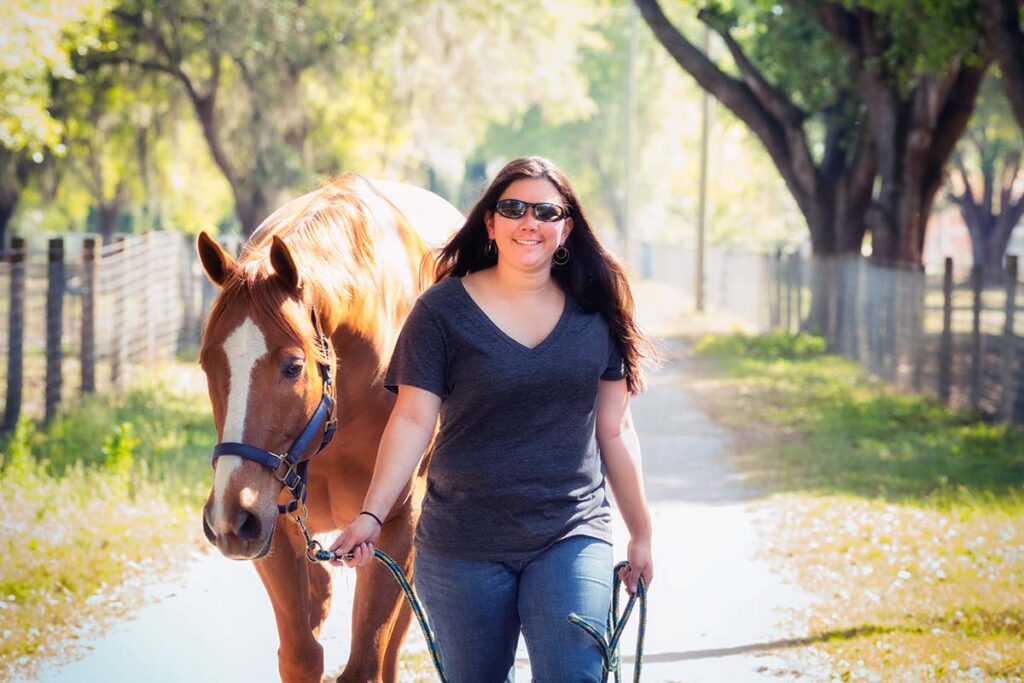As we touched on in “How Horses Learn,” all animals learn, or make changes to their future behavior, as a result of the consequences that follow their behavior. While undesirable consequences make behaviors less likely to occur, in this article we’ll focus on positive reinforcement horse training—how we can use desirable consequences to make behaviors more likely to occur, thus achieving training goals.
What Is Positive Reinforcement?
When a horse performs a behavior that leads to desirable consequences, the horse is more likely to behave that way in similar future circumstances. For example, if a horse in a drylot leans over a fence rail and as a result accesses the tall grass in the neighboring pasture, he’ll be more likely to repeat that behavior of leaning over the fence rail. When this occurs, it is because the behavior has been positively reinforced. Positive in this instance isn’t a judgment statement—it just means something was added (accessing grass). Additionally, when that behavior recurs as a result of its consequences, we say the behavior has been reinforced.
Behaviors can be, and often are, positively reinforced when no people are involved. However, as trainers we can capitalize on this learning phenomenon to achieve our training goals. Here is a simple example of how you can positively reinforce behavior in training:
We approach the front of a horse’s stall. When the horse walks up to the stall door voluntarily, we give him a small, tasty treat. If we repeat this process a few times, he’ll likely continue the behavior of walking to the stall door.
Trainers who use positive reinforcement tend to do so in a structured, precise way. Doing so allows them to teach their horses almost anything, from trailer loading to flying lead changes or sliding stops to taking dewormer while unrestrained in the pasture. This is done via shaping and using marker signals.

Positive Reinforcement Horse Training: Shaping
Shaping is the act of taking a complex end goal behavior and breaking it down into small, easily achieved steps. For example, if we wanted to shape the horse’s behavior of walking up to the stall door, we would positively reinforce “approximations” that led to that goal: Turning to look at us; orientating the body to face us; taking one step toward us, and so on. I recommend clients write out short shaping plans—a list with no more than 10 approximations—to help guide them as they work with this new training technique.
Positive Reinforcement Horse Training: Marker Signals
A marker signal is generally a unique sound that comes to mean two things to the horse simultaneously. It precisely signals, “Yes! That is the exact behavior I wanted,” and “Please stand by for a desired consequence.” Mechanical clickers are popular marker signal devices. Many people, however, use a sound, such as a tongue cluck, as their marker signal so they can keep their hands free. The desired consequence here is usually a small, tasty treat. Using the shaping example above, the trainer would mark and then reinforce every approximation building toward the end goal behavior.
It’s worth noting that while we can make associations between our behavior and consequences that occur much later, horses cannot. The timing of the marker signal is critical. We should mark the behavior the moment it happens, not after. If our timing is slower, we might end up marking—and getting—a behavior we don’t want. Equally important, the delivery of the pleasant consequence comes after the behavior has been marked.
In Summary
Horses taught using positive reinforcement have been shown to strongly retain the lessons learned. Additionally, because this technique doesn’t involve pressure, it doesn’t cause the horse pain or undue stress while learning.
As with any training method, we recommend you have qualified supervision as you learn to use positive reinforcement. While techniques such as negative reinforcement or positive punishment carry greater risk of harm when used inappropriately, poorly applied positive reinforcement might cause horses to feel frustration or stress, or they might learn undesirable behaviors such as “mugging.” While these issues reflect poor application of this technique, they don’t mean the technique itself is inherently “bad.”
Positive reinforcement done well can indeed be a powerful tool in our training toolbox, helping us achieve training results we didn’t think possible in a way our horses also enjoy.
Related Reading:
Lauren Fraser, MSc, FFCP, has helped people understand horse behavior problems since 2006. With a background working as a horse trainer, an MSc in clinical animal behavior, and more than a decade working as an equine behavior consultant, Lauren’s approach gets to the heart of why horses behave the way they do and addresses issues using low-stress methods. Lauren also guest lectures at universities, presents at conferences, and creates educational programs for horse owners and equine professionals.
Are you enjoying this content? Sign up for My New Horse’s FREE newsletter to get the latest horse owner info and fun facts delivered straight to your inbox!








